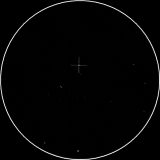
| 4 Vesta |
|---|
Designation |
4 Vesta |
|
Discovered |
1807. |
|
Type |
Asteroid |
|
Distance from Sun |
353 millions km (2.632 AJ) |
|
Orbital inclination |
7.133° |
|
Eccentricity |
0.089 |
|
Dimensions |
578x560x458km |
|
Greatest apparent magnitude |
5.30 |
|
4 Vesta is the second most massive object in the asteroid belt, with a mean diameter of about 530 km (around 330 miles) and an estimated mass 9% the mass of the entire asteroid belt. Its size and unusually bright surface make Vesta the brightest asteroid, and the only one ever visible to the naked eye from Earth besides Ceres, which is visible under exceptional viewing conditions. Due to the availability of rock samples in the form of the HED meteorites, it has also been the most studied. Vesta was discovered by the German astronomer Heinrich Wilhelm Olbers on March 29, 1807. He allowed the prominent mathematician Carl Friedrich Gauss to name the asteroid after the Roman virgin goddess of home and hearth, Vesta. Vesta is the second-most-massive body in the asteroid belt. Vesta does have a differentiated interior. Vesta's shape is relatively close to a gravitationally relaxed oblate spheroid. Its rotation is relatively fast for an asteroid (5.342 h) and prograde, with the north pole pointing in the direction of right ascension 20 h 32 min, declination +48° with an uncertainty of about 10°. This gives an axial tilt of 29°. Temperatures on the surface have been estimated to lie between about -20°C with the Sun overhead, dropping to about -190°C at the winter pole. Typical day-time and night-time temperatures are -60°C and -130°C, respectively. Its size and unusually bright surface make Vesta the brightest asteroid, and it is occasionally visible to the naked eye from Earth. In late May and early June 2007, because Vesta's perigee and perihelion are only a few weeks apart, it will reach a peak magnitude of +5.4, the brightest since 1989. During this period it can been seen in the constellation Scorpius near Jupiter and Antares. The first space mission to Vesta will be NASA's Dawn probe, which will enter orbit around the asteroid for nine months in 2010-2011. |
||
VEDRAN VRHOVAC© 2006.-2007. |
